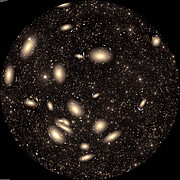NSF NOIRLab Presents Messengers of Time and Space Planetarium Show
Free-to-download planetarium show captures how astronomers at the International Gemini Observatory and NSF–DOE Vera C. Rubin Observatory use time-domain and multi-messenger observations to understand our changing Universe
22 May 2025
Messengers of Time and Space is a new fulldome planetarium show designed to illuminate the imminent revolution in astronomy driven by time-domain and multi-messenger observations. This free, immersive experience invites audiences to explore the dynamic cosmos and witness the transformative impact of real-time data on our understanding of the Universe.
Today, NSF NOIRLab, funded by the U.S. National Science Foundation (NSF), has released the fulldome planetarium show, Messengers of Time and Space. This free-to-download production brings the combination of the International Gemini Observatory, funded in part by NSF and operated by NSF NOIRLab, and NSF–DOE Vera C. Rubin Observatory, funded by NSF and the U.S. Department of Energy's (DOE) Office of Science and jointly operated by NOIRLab and DOE’s SLAC, to the forefront of humanity’s quest to understand our ever-changing cosmos. The release of this show comes in preparation of Rubin Observatory’s First Look image release, expected later this year.
The world premieres of the new show were held at ʻImiloa Astronomy Center in Hilo, Hawaii, and Flandrau Science Center & Planetarium in Tucson, Arizona, on the evening of 22 May 2025.
This immersive planetarium show was made possible through an NSF grant, Gemini in the Era of Multi-Messenger Astronomy (GEMMA), which is aimed at advancing the leadership role of the International Gemini Observatory in the area of multi-messenger astronomy. The grant also supports upgrading the International Gemini Observatory with innovative new instrumentation and infrastructure to support time-domain and multi-messenger follow-up observations. GEMMA has also supported several educational and communications initiatives, which, in addition to this planetarium program, include classroom materials to promote careers in related science and technology fields and training workshops for science writers.
Modern astronomical surveys, like the upcoming Rubin Observatory Legacy Survey of Space and Time (LSST), will detect up to 10 million changes in the sky every night, with alerts generated within minutes. Yet, many of these alerts will require additional observations to understand the physical phenomena. Observatories providing this critical follow-up must become capable of responding quickly and efficiently. With the new improvements provided by the GEMMA project, Gemini will become a global leader in these follow-up observations, able to study the faintest, highest-priority targets.
The planetarium show highlights how Gemini will work together with observatories that monitor the night sky for exciting astronomical events that change with time, like Rubin Observatory. Sometimes, light is not the only indicator of these short-term events. Audiences will learn how information can reach us through other messengers like cosmic rays, elusive particles called neutrinos, and even gravitational waves rippling through the Universe.
“Astronomy is heading in so many exciting new directions, from survey instruments like the Vera C. Rubin Observatory to the fleeting gravitational wave signals from colliding neutron stars and black holes,” says Peter Michaud, director of the show. “Both multi-messenger and time-domain astronomy are revealing new cosmic mysteries every night. Understanding how astronomers are unraveling these mysteries is what audiences will experience when they visit their local planetarium and immerse themselves in this show.”
By making Messengers of Time and Space available for free, NOIRLab and NSF aim to empower planetariums worldwide to provide high-quality programming and engage audiences with state-of-the-art fulldome content. “It’s a joy to be able to bring this show to the planetarium community,” says Ron Proctor, NOIRLab Motion Graphics Designer and producer of the film. In addition to the full show, individual clips and frames will be available to download online.
Parts of Messengers of Time and Space were made using Blender, a free and open-source 3D computer graphics software. “Blender is free to the public, sharing the NOIRLab value of distributing scientific visualization resources and allowing us to broaden the reach of scientific understanding,” says Proctor.
The show is available in 4K fulldome format and can be downloaded online. Also available are a trailer, movie poster, educational materials, and script. We encourage the community to produce their own translations and narrations. We welcome receiving copies of the translated scripts and audio files to share with the community.
More information
NSF NOIRLab, the U.S. National Science Foundation center for ground-based optical-infrared astronomy, operates the International Gemini Observatory (a facility of NSF, NRC–Canada, ANID–Chile, MCTIC–Brazil, MINCyT–Argentina, and KASI–Republic of Korea), NSF Kitt Peak National Observatory (KPNO), NSF Cerro Tololo Inter-American Observatory (CTIO), the Community Science and Data Center (CSDC), and NSF–DOE Vera C. Rubin Observatory (in cooperation with DOE’s SLAC National Accelerator Laboratory). It is managed by the Association of Universities for Research in Astronomy (AURA) under a cooperative agreement with NSF and is headquartered in Tucson, Arizona.
The scientific community is honored to have the opportunity to conduct astronomical research on I’oligam Du’ag (Kitt Peak) in Arizona, on Maunakea in Hawai‘i, and on Cerro Tololo and Cerro Pachón in Chile. We recognize and acknowledge the very significant cultural role and reverence of I’oligam Du’ag to the Tohono O’odham Nation, and Maunakea to the Kanaka Maoli (Native Hawaiians) community.
Links
- Link to download Messengers of Space and Time
- International Gemini Observatory website
- Photos of Gemini South telescope
- Videos of Gemini South telescope
- Photos of Gemini North telescope
- Videos of Gemini North telescope
- Vera C. Rubin Observatory website
- Vera C. Rubin Observatory images
- Check out other NOIRLab Organization Releases
Contacts
Lars Lindberg Christensen
Head of Communications, Education & Engagement
NSF NOIRLab
Email: lars.christensen@noirlab.edu
Josie Fenske
Jr. Public Information Officer
NSF NOIRLab
Email: josie.fenske@noirlab.edu
















